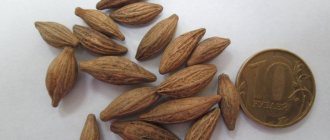Clematis is the favorite flower of all gardeners and designers. "Clema" is a lush vine with colorful flowers from ancient Greece. Essentially, it is a shrub with a single stem that spreads along the ground in loops or upward along a support. With its help, the Greeks created fabulous arches and gardens. In our country, clematis is most often called “clematis” because of the strong smell of its roots and the curved shape of the seeds.
This plant has about 300 diverse species. Landscape designers love to combine different varieties, creating colorful compositions. Clematis in landscape design are usually used:
- To create a living fence so that strangers will be less likely to peek into your yard but still enjoy the colorful flowers.
- For decorative decoration of walls, gazebos, arches or fences. On hot summer days, a clematis fence will save you from the scorching rays of the sun, and in bad weather it will protect you from rain and wind.
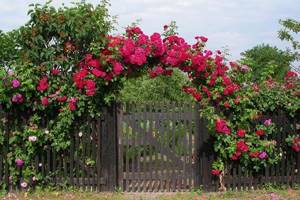
- To decorate rock gardens, let the plant trail over the stones, like a wild plant. This will add an original twist to the rocky building.

- To decorate tree trunks, placing the vine stems in a circle, over time it will completely encircle it and give a stunning composition. Planting multi-colored species will add color to the garden, and different trees will have their own colors.
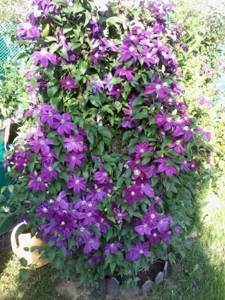
- For the background when creating flower beds and flower beds, a soft one-color carpet will emphasize the individuality of other colors

- For a single planting, one or several species, planting several different species side by side and intertwining them will create a multi-colored palette of colors.
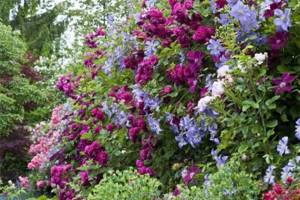
- For growing in decorative flowerpots and boxes, this will help decorate not only the outside of the gazebo, but also the inside.
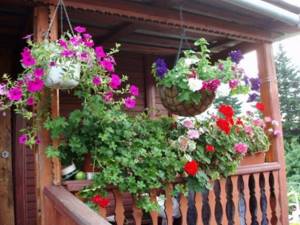
Most often, clematis are used for vertical flowering, but a multi-colored carpet on the ground without any supports will look no less impressive.
Advice! In vertical gardening, clematis are also used for practical reasons. For example, in order to hide an ugly wall or an old fence.
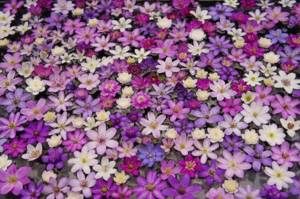
To get more effect from the flowering of clematis, select varieties with different flowering periods so that its colors will delight you all summer and autumn.

When planning to plant clematis on a plot, you need to know the disadvantages associated with its growth:
- Over time, the plant grows greatly and the area of the site becomes much smaller.
- The vertical wall provides a lot of shade and new representatives of the fauna can appear in it.
- Also, dampness accumulates in the shade, which is why you should not plant clematis on walls facing north.
- An overgrown vine can cause a clogged gutter. You need to keep an eye on this and trim it in time.
- Plants growing around windows can block sunlight from entering your home.
Clematis in landscape design: benefits of use
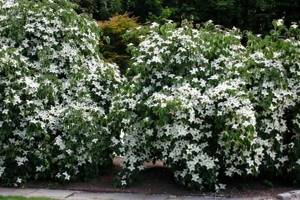
And you shouldn’t even think about considering clematis in landscape design solely as a single plant that can perfectly decorate your garden exclusively on its own. Often, clematis look much more striking in compositions in which other plants take part.
In addition, when purchasing clematis, you should never limit yourself to just one variety. It would be much better to buy seedlings of several varieties that will bloom at different times. By wisely choosing the timing of flowering of different varieties, you can ensure that this climbing plant will delight you with its beauty throughout the entire season. And this takes into account the fact that many varieties are capable of blooming both in early spring and late autumn.
Another big mistake many gardeners make is that they believe that clematis is a plant that grows exclusively by twining around a support, like a grape vine. However, we must never forget that in addition to climbing (large-flowered) clematis, there are also small-flowered ones, the shoots of which do not grow above a meter at all. And they, by the way, are also very actively used in garden decoration.
If you are afraid of getting lost in the endless variety of clematis varieties that can be purchased, you are doing it for good reason. At the moment there are so many of them that it is simply impossible to know everything.
Some varieties were bred back in the nineteenth century, and they are actively used to this day. And some were introduced only a couple of years ago, and even despite this, they have already gained enormous popularity. However, in this article we will try to help you choose the most suitable variety to suit your personal situation.
Growing conditions
Not only landscape design masters have the opportunity to decorate a summer cottage. Beginners should pay attention to undemanding crops when planting. Clematis is a relatively unpretentious perennial plant and will become a worthy element of landscape design. Usually it adapts to any conditions, with the exception of summer cottages with highly moist soil. In swampy soil, the roots of the vine die. Therefore, a high-quality drainage layer is a prerequisite when choosing clematis as an element of landscape design. Preference for planting on a summer cottage is given to sunny places, but semi-shaded areas are also suitable for growing.
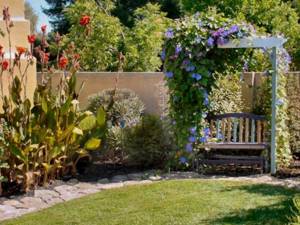
Clematis needs periodic fertilization, regular watering and weeding, just like any other ornamental crop. The volume of water depends on the height of the vine and the degree of development of the root system. Young shoots need 10 liters, an adult clematis bush requires up to 5 buckets. The guideline is to moisten the soil to a depth of 0.5 m. You cannot pour water directly under the root.
Comment! Evidence of improper care is the dropping of leaves and rare flowering.
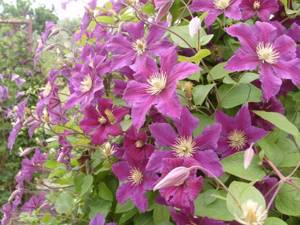
To ensure that your landscaping efforts are not in vain, it is important to strictly follow the conditions of clematis agricultural technology. Urea is used as a fertilizer in spring. Before flowering, fertilize with peat, compost or manure. Regular spraying promotes lush flowering of clematis in your summer cottage. Pruning is carried out in the fall until the first bud. Sometimes the procedure is organized earlier if there is a need to remove damaged areas. Timely procedure ensures active growth of new shoots in spring. Clematis is propagated by cuttings or dividing the mother bush.
Clematis, which is represented by many varieties and species, will help you organize a unique landscape design at your summer cottage. Choosing a suitable site and neighbors for an ornamental plant, providing timely and competent care are the key conditions for obtaining an exquisite composition in the landscape design of a dacha area.
Recommended Posts
Perennial unpretentious flowers for the garden
Mixborders of perennials in landscape design
Decorative border for flower beds
DIY outdoor flowerpots
Using astilbe in landscape design
Garden crafts made from bottles
Clematis varieties for background or single planting in the garden
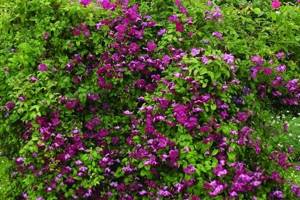
Photo of clematis Abundance
As already mentioned, gardeners most often use clematis in landscape design precisely to decorate fences, trellises or gazebos. In addition, clematis vines can easily climb the walls of houses. However, in this case, it is necessary to ensure that water does not drip from the roof onto the plant: it extremely does not like waterlogging.
Naturally, for these purposes we will use large-flowered clematis in landscape design, which are the leaders in popularity compared to small-flowered ones.
When choosing a cultivar to create a strong background splash of color, it is not the sophistication and elegance of the cultivar that needs to be considered, but rather the number and brightness of the flowers. After all, no one will look at the bizarre shapes of a flower “somewhere in the background.” But a large number of simple but bright colors will be visible from afar, and it will look very juicy.
To create a bright color background, you can use clematis in landscape design such as:
- Abundance
- Birjuzinka
- Comtesse de Bouchaud
- Ernest Markham
- Ethica
- Etoile Violette
- H. F. Young
- Jackmanii
- Jubileinyi 70
- Kardinal Wyszinsky
- Kiew
- Kosmiczeskaja Melodija
- Luther Burbank
- Margot Koster
- Polish Spirit
- Romantika, Ryytel
- Star of India
- The President
- Tuczka
- Victoria
- Ville de Lyon
- Viola
Creating a single planting of clematis
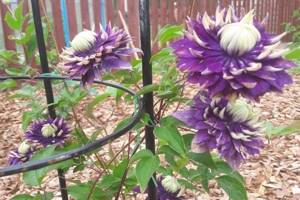
Another technique that is now becoming fashionable is planting clematis in a single planting. Or in a small group of two or three bushes. And in this case, it’s worth paying attention to how exquisite the shape of the flowers is, because attention will be drawn to them much more closely, and you will want to look at the small details much more.
Most often, in order to provide such a variety with support that will not distract with its zero decorativeness, you can use various creative approaches. For example, a support in the form of an umbrella will look not only very original, but also very beautiful. You can come up with hundreds more interesting solutions, but the most important thing is to make sure that they fit into the overall ambiance of the garden.
But even more important is the correspondence between the support you choose and the variety of clematis that you want to grow on it. The average height must match, and it is also worth considering the speed at which a particular variety grows. Do not forget that some of them are especially sensitive and cannot tolerate strong winds.
If you take into account all these important factors and can choose a support that matches them, your site will shine with new colors.
However, otherwise you can only ruin your experience of growing beautiful clematis. It may well happen that, being grown on a support that is too low for themselves, clematis shoots become entangled, which leads to a deterioration in their decorative effect and the lushness of flowering.
But, even if you couldn’t find a good support for the clematis variety you liked, don’t despair. Remember that there are so many varieties that, instead of choosing a support for your clematis, you can very well choose a clematis for your support. Plus, they are all incredibly beautiful, so you won’t regret your choice in any case.
Classification of clematis
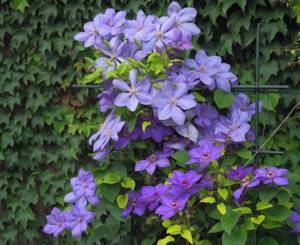
The main criterion for dividing into species is the closest relative on the mother’s side:
The "Jacman" species is a vine 3-4 meters long, with a strong and developed root. Its flowers are blue, violet or purple, odorless, up to 20 centimeters in diameter. On branches they can be located in small groups of 3-4 pieces or grow one at a time.
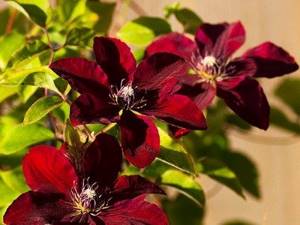
Type "Florida" - the length of their vines reaches up to 3 meters. It blooms in late spring early summer, with light flowers approximately 12 centimeters in diameter.
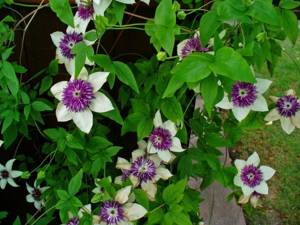
The Viticella species is about 3 meters long, with flowers in red shades such as pink, crimson and purple. They are approximately 12 centimeters in diameter. This species is distinguished by the rich splendor of flowering.
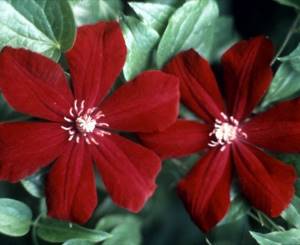
The species “Lanuginosa” is not too long, up to 2.5 meters, with large blue or white flowers. At the end of spring, hundreds of inflorescences appear on the bushes; by mid-summer, another flowering is possible, but more rare.
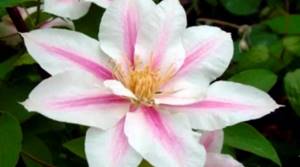
View "Patens" - blooms twice, the first in spring. Its flowers are quite unusual, star-shaped, up to 15 centimeters in diameter. The colors are amazing, from light to dark purple.
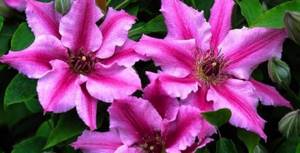
The “Integrifolia” species is more like a bush up to 1.5 meters high. Blooms in mid-summer in a variety of colors.

The species "Small-flowered" - so called for their small flowers, reaching only 4 centimeters in diameter. It begins to bloom earlier than all other species.

Of course, there are many more types and varieties of clematis and only narrow specialists in floriculture know them all.
Clematis in landscape design: the best pairs
It is also important to remember that varieties can be combined in single plantings. However, overdoing it is a bad idea. Two or three varieties are enough, but four is too much. But in order to correctly select varieties that are ideally in harmony with each other, you need to have a subtle design sense, which is inherent in some to a greater extent, and in others to a lesser extent.
However, in order not to be unfounded, we will give a couple of examples: two varieties of different flower sizes will go very well together. Thus, large-flowered clematis can harmonize well with small-flowered clematis, but only when one of them is somewhat brighter and more expressive than the other. Otherwise, the harmony will be disrupted and your flowerbed will look like two different varieties are fighting for your attention. This cannot be allowed.
Perhaps it’s worth giving a more specific example, which you can easily use in your own garden. Purpurea Plena Elegans has small creamy pink flowers that are ideal for highlighting other varieties but not for planting on their own. But they can highlight the beauty of such varieties as, for example, Bees Jubilee or Carnaby, which have large, rare, but very expressive and attention-grabbing flowers.
In this example, we can see how two varieties that are completely different from each other form together an ideal tandem that attracts the eye.
However, pairs can be made not only from different varieties of clematis. For example, both large-flowered and climbing varieties, as well as small-flowered terry varieties, harmonize very well with lush, delicate roses. The main thing is to choose the colors correctly.
Clematis and roses in landscape design - photo
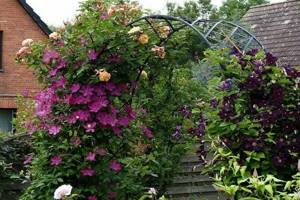
Rose and clematis are a very good pair. Not only do they look incredibly beautiful together, these plants also do not interfere with each other's development, unlike many other pairs. For example, many tall plants planted next to clematis immediately begin to compete with it for nutrients. Rose lives with clematis in “harmony and harmony”
If you choose this particular pair to decorate your garden, it is worth considering that the best supports for them will be ordinary arches, fences and gazebos. However, you can use both them and pyramids or steles.
If you don't know which clematis varieties will make the best company for roses, refer to the ones below. They will not only look harmonious, but will also have the same flowering period as the rose itself:
- Aljonushka
- Arabella
- Durandii
- Hendersonii
- Juuli
- Alba Luxuriens
- Abundance
- Betty Corning
- Entel
- Little Nell
- Mary Rose
- Minuet
- Purpurea Plena Elegans
Also, recently it has become very fashionable to plant roses and clematis together in the form of hedges. It is best to use for these purposes those varieties of clematis that do not have to be pruned every year.
If you don’t like any of the above varieties, then absolutely any variety belonging to the third pruning group is perfect for the same purposes. For example, almost all clematis of the Viticella species belong to this group, so they will definitely suit you.
At the end of the season, such clematis are cut off almost at the root. The cut is made at a height of about 10-20 centimeters above the ground, after which they are covered with compost and covered for the winter. Such clematis bloom on the shoots of the current year, and that is why there is so little hassle with them. However, unfortunately, they are not suitable for creating a hedge.
Clematis and other plants in garden landscape design
In addition to roses, many different plants can make excellent company for clematis. Among them we can highlight, for example, viburnum, lilac, forsythia or deutia. All of them, like the rose, will not compete with clematis, and their inflorescences will harmonize very well with each other.
Other climbing plants also look good with clematis. For example, almost any grape variety can be planted next to clematis. It feeds mostly through photosynthesis, and therefore will not interfere with the clematis's nutrition. Well, the beauty of their tandem, especially when the grapes ripen, is simply impossible to convey in words.
However, if you want to achieve the best combination of grapes and clematis, you need to choose the right variety. And, if you can choose almost any grape, it is better to choose small-flowered or grape-leaved clematis.
Examples of such varieties are clematis Jouiniana, Praecox, Petit Foucon or rouguchi. Almost all hybrids created on the basis of these varieties are also suitable.
Joint planting: clematis and roses
Classic partners of clematis are roses. For planting with roses, groups such as the large-flowered late-flowering Jacquemman hybrids, the Viticella group and the low-growing Integrifolia group are suitable. For an arch, paired with climbing roses, it is better to choose varieties of the Jacquemman or Vititsella group, and for bush roses, clematis of the integrifolia group would be an ideal partner. Roses and clematis can be chosen to match, or they can be diversified with contrasting combinations, for example, orange and purple.

How to beautifully plant clematis in your garden?

Recently, compositions involving clematis and all kinds of conifers, such as thuja, have become incredibly popular. Clematis are also often planted in the same garden with ornamental shrubs. Growing clematis in so-called gravel gardens, which are now in great demand, has become no less popular.
Naturally, there are specially bred varieties for such compositions that fit perfectly into the coniferous-gravel landscape. Among them we can distinguish, for example, varieties such as:
- Alba
- Rosea
- Blauer Aihat
- Olgae
- Pangborne Pink
Small-flowered and medium-flowered clematis also look very harmonious in gravel gardens. There are also a huge number of varieties: choose any one, and it will give you beauty season after season.
Clematis in landscape design - variety “Knyazhik”
This variety has proven itself very well recently. Many even call it one of the best ground cover crops of recent years. And if you want to place it in the shade, it has absolutely no equal. And the flowering period of these clematis can be described as ideal. They bloom in May, but they will delight the eye right up to frost.
Until June or (at best) July, the Princes will bloom, but throughout the autumn season they will decorate your garden with their leaves, no less beautiful than the inflorescences, and fruits that look like large fluffs. With their silvery sheen, they even look somewhat like earrings.
Decorating an old tree with clematis
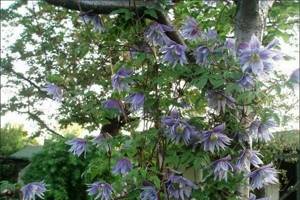
Decorating an old tree with clematis “Prince”
Another excellent use of clematis in landscape design, which we have not previously mentioned, is to almost completely cover the trunks of old trees with them. You can even decorate a completely dried tree.
And it is for this task that the Princes are perfectly suited. With their small but numerous flowers they cover the old trunk and transform it from a shame into a real decoration of your site.
Of course, Knyazhiki is not the only variety suitable for this task. Instead, you can use almost any small-flowered clematis. Some hybrid varieties can cope with the task just as well.
Large-flowered varieties, of course, are somewhat less suitable for this task, however, if they bloom sufficiently magnificently and abundantly, they can also be used to decorate an old tree. Although, if it has dried completely, a decoration made from large-flowered clematis will look much worse than the same one made from small-flowered clematis.
Growing clematis in containers
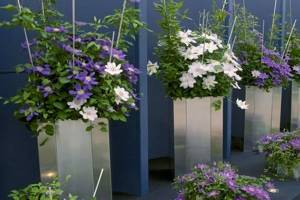
In addition to the fact that growing ornamental crops in containers has recently gained great popularity, it is also very convenient. Just think: at any time you can move your clematis almost anywhere, change the accents and even the entire composition as a whole.
Ceramic vases and containers are often used for these purposes, however, this is actually not the best idea. It's all about the cold. However, the problem is not that the vase is not the best protection from frost. It lies in the fact that the vase itself may well crack from too low temperatures. Therefore, much more suitable material for creating a container would be wood, plastic or even metal.
What is a “Blooming Conveyor” and how to create it on your site?
Unfortunately, many gardeners prefer not to notice small-flowered clematis at all. On the one hand, they can be understood. In the end, large saucer-shaped inflorescences look much more beautiful and solid than small flowers. However, these “babies” should not be underestimated at all, because they are, in fact, very beautiful and can be used in a very interesting way, which we will talk about below.
Among the small-flowered clematis, which gardeners may, in principle, not even know about, there are a huge number of very abundantly flowering varieties that can serve as both a background and a full-fledged decorative element. Also, do not forget about Princes, the use of which is limitless, and all kinds of natural types of clematis.
However, as already mentioned, they all have very interesting applications, which, by the way, will allow you to contemplate the flowering of clematis from May until the cold weather. We are talking about the “Blooming Conveyor”, and this technique, to be honest, is not at all complicated, and absolutely anyone can use it. However, very few people have even heard of it, and therefore we will gladly tell you everything about it.
The essence of this method is as simple as two pennies. It consists of selecting varieties that will grow in your garden in such a way that as soon as one fades, the flowers of another will bloom. Planning such a “Conveyor”, of course, will take a lot of time, but the result is definitely worth it.
To make it easier for you to navigate, we will give an example of such a “Conveyor”:
All kinds of small-flowered clematis and Princes “launch” a season lasting more than six months. They begin to bloom at the very beginning of May, and although many gardeners do not consider them beautiful, these clematis create a real fairy-tale ambiance in your garden. The flowering of the Princes will end in about two months. And then the next varieties will arrive.
In fact, they will begin to bloom at the end of May, when the Knyazhivo season is in full swing. One of the first to bloom is the straight clematis, which will bloom until the end of June, and sometimes, if, of course, the weather is favorable, until mid-July.
As June comes to an end, the highlight of our program begins to bloom: large-flowered clematis. Of course, these dates are very inaccurate, because the final verdict on exactly when a particular variety will bloom is left by the weather, which is simply impossible to predict with high accuracy.
However, there are also factors that, unlike the weather, you can completely influence. These include soil moisture and nutritional value, as well as the amount of light you provide to your plants.
By the second half of June, all clematis varieties of the third pruning group begin to bloom. Their flowers grow on the current year's shoots, which is why they bloom later than usual. Also, by this time, almost all purple hybrid varieties of clematis will arrive.
By mid-July, the real peak of growth of large-flowered clematis begins: almost all varieties by this time already delight the eye with inflorescences of various shades and sizes. Some of them will maintain flowering until the first frost.
In August, clematis of the second pruning group are the last to bloom. More precisely, this is their second flowering period. These clematis bloom twice a year: the first time - on the shoots of the previous year in June or July, and the second time - on the shoots of the current year, but somewhat later - in August. However, the sad thing is that this bloom is different from the first one in that it is a little dimmer.
However, if you live in a warm enough climate and you have cared for your clematis very well, it is quite possible to get almost the same results from the second wave of flowering as the first. Although, apart from your own efforts, you will have to hope for good weather.
All the remaining months until the first cold weather, all kinds of large-flowered varieties will fade. If frosts do not set in too severely, it is quite possible that the last flower will fall not even in September, but already in October. However, again, this depends on very unpredictable factors.
This is exactly how the real “Blooming Conveyor” works. It cannot be said that creating one in your garden is the simplest task, however, if you try and plan everything well, you can observe a kaleidoscope of small and large, variegated and delicate, double and velvety clematis flowers throughout the entire warm season and even a little more.
Where would clematis look best?
Clematis can beautifully decorate a garden house; it is best to place the plant on the southern or southwestern sides. It is important to note that clematis should be planted so that water does not fall on them, respectively, stepping back a little from the walls, at least 50 centimeters. It is not recommended to plant clematis near walls because the plants are so strong that during the growth process they can spoil the roof, especially if it is made of tiles. The walls also have a heating feature, and therefore it is advisable to place the support at a distance of at least 20 centimeters; clematis do not like excessive unnatural heat. Note that the closer to the building you plant clematis, the more it will need additional watering, since the soil near the foundations is always drier. Clematis has many colors, and therefore, having decided to plant it in your garden, think carefully about the overall picture; crimson, violet and purple flowers are perfect for light buildings and structures; on the contrary, varieties of white, pink and even blue will be appropriate for dark ones shades. If there is good lighting in the house, you can safely wrap clematis around one of the windows, and low-growing shoots can be used to decorate the wall space under the window sills. But don’t overdo it; a garden house or main home should not turn into a flower bed of clematis; this will not add charm to either the buildings or the flowers themselves.
Clematis are also perfect for flowering screens, which can be used to cover a small and cozy place to relax; for such decorations, varieties with powerful flowering should be used. A wonderful composition can be created if you plant several plants along the garden paths; moreover, if you alternate colors, it will turn out very lush and festive. By the way, it is not at all necessary for the varieties to bloom simultaneously; it will be even better if one “catch up” with the other.
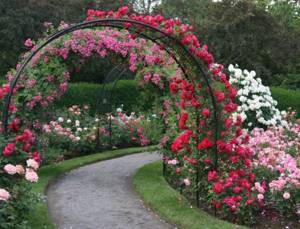
What elements are clematis combined with in landscape design?
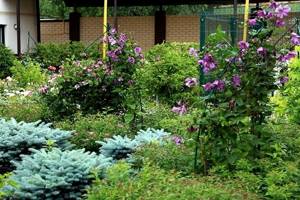
Recently, summer residents and gardeners are increasingly experimenting with how, where and with what to plant clematis. For example, it has recently become very popular to plant these climbing plants in shrub borders. In addition, as already mentioned, roses will be a very good company for them there.
The best clematis for planting with roses are those belonging to the Integrifolia species. These clematis are unusual in that, unlike many of their relatives, they do not know how to cling to other plants. However, between the branches of plants such as roses, they stay very confidently. As you can see, these two flowers complement each other perfectly.
Most often, clematis flowers from this group have a rather unusual shape. Many would describe them as a bell or a bell. Their coloring can be completely different. Every color of clematis you can imagine - pink, blue, purple, yellow, red - is exactly represented in this group.
Their flowers, moreover, are not too large, and therefore they ideally play the role of some kind of supplement for roses, which they desperately need. In the end, it is not so interesting to look at a lonely rose bush than at a whole composition in which not only they, but also clematis take part.
In addition, any other vine or vine can be an excellent addition to clematis when creating, for example, a hedge. As we have already noticed, this plant looks especially harmonious with grapes. Although it is not an ornamental plant, in combination with clematis, grapes perfectly perform this function, decorating the garden especially during the period of fruit ripening.
And, of course, we should not forget that, first of all, clematis are climbing plants, and for them you can find a lot of interesting solutions and applications in landscape design. Their number is limited solely by your imagination: lampposts entwined with vines, walls with living drawings of flowers. All this is not only possible, but also must be done if you want to make your work in the garden more enjoyable.
In landscape, and, in principle, in any design, there is a simple rule: opposites attract. And therefore, we decided to end our article by presenting you with the best possible pair for clematis. And these are coniferous plants.
Yes, roses are quite good if your clematis bush is no more than two meters. However, there are also those whose length reaches not only four, but also five meters. Such giants need a matching pair, and pine needles are the ideal candidate.
Compared to clematis, which looks delicate and fragile, the needles stand strong and immovable. These two completely different plants complement each other so well that entire gardens are created based on their tandem. Clematis of the third pruning group look especially good next to the needles. Most often, they form a pair with thujas and miniature pines in such gardens.





